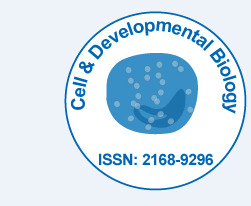
Cell & Developmental Biology
Open Access
ISSN: 2168-9296

ISSN: 2168-9296
Commentary - (2025)Volume 14, Issue 1
Chromatin remodeling complexes play essential roles in developmental gene regulation by modifying chromatin structure and accessibility to enable precise spatiotemporal control of gene expression. These ATP-dependent molecular machines alter nucleosome positioning, stability, and composition, thereby regulating transcription factor access to DNA regulatory elements. The coordinated action of multiple chromatin remodeling complexes creates dynamic chromatin landscapes that facilitate the complex gene expression programs underlying embryonic development, cell fate specification, and tissue morphogenesis.
The major families of chromatin remodeling complexes include Switch/Sucrose Non-Fermentable (SWI/SNF), Imitation Switch (ISWI), Chromodomain Helicase DNA-binding (CHD), and Inositol-Requiring 80 (INO80) complexes. Each family exhibits distinct mechanisms of nucleosome remodeling and regulatory functions. SWI/SNF complexes primarily function as transcriptional activators by ejecting nucleosomes from promoter and enhancer regions, while ISWI complexes typically slide nucleosomes to create regularly spaced nucleosome arrays. CHD complexes exhibit both activating and repressive functions depending on their subunit composition and genomic context. INO80 complexes specialize in nucleosome replacement and DNA repair processes.
The SWI/SNF complex family includes several distinct complexes with specialized functions in development. The BRG1/BRM-Associated Factor (BAF) complex is essential for embryonic development and contains the catalytic subunits BRG1 or BRM along with various regulatory subunits. The Polybromo-Associated BAF (PBAF) complex contains unique subunits including PBRM1 and ARID2 that confer distinct targeting specificity. The recently discovered non-canonical BAF (ncBAF) complex lacks several canonical subunits and exhibits specialized functions in neural development. The subunit composition of these complexes changes during development, creating context-specific remodeling activities.
Chromatin remodeling complexes regulate key developmental transitions through their control of master transcription factor accessibility. During the maternal-to-zygotic transition, chromatin remodeling complexes facilitate the binding of zygotic transcription factors to previously inaccessible chromatin regions. The pioneer transcription factors that initiate these transitions often work in conjunction with chromatin remodeling complexes to establish accessible chromatin domains. This coordinated action creates feed-forward loops that reinforce developmental gene expression programs and ensure robust cell fate transitions.
The regulation of enhancer activity represents a critical function of chromatin remodeling complexes in development. Enhancers are regulatory DNA sequences that control gene expression over long distances and are essential for establishing tissue-specific gene expression patterns. Chromatin remodeling complexes are recruited to enhancers by sequence-specific transcription factors and cofactors, where they create accessible chromatin structures that facilitate transcription factor binding and RNA polymerase recruitment. The dynamic regulation of enhancer accessibility allows for the precise temporal and spatial control of developmental gene expression.
Polycomb Group (PcG) proteins work in opposition to chromatin remodeling complexes to maintain repressive chromatin states at developmental genes. The Polycomb Repressive Complex 1 (PRC1) and PRC2 establish repressive histone modifications and compact chromatin structure at target genes. Chromatin remodeling complexes can antagonize polycomb function by disrupting repressive chromatin structure and facilitating the binding of activating transcription factors. This antagonistic relationship creates a dynamic balance that regulates the timing of developmental gene activation.
The SWI/SNF complex exhibits particularly important functions in neural development through its regulation of neural-specific gene expression programs. The complex undergoes developmental stage-specific changes in subunit composition, with the incorporation of neural-specific subunits such as BAF53b and BAF45b during neurogenesis. These subunit switches alter the complex's targeting specificity and functional properties, enabling the activation of neural-specific genes while repressing non-neural genes. Mutations in SWI/SNF subunits are associated with intellectual disability and autism spectrum disorders, highlighting the importance of chromatin remodeling in neural development.
Chromatin remodeling complexes also play key roles in maintaining genome stability during development. The INO80 complex participates in DNA damage repair pathways and replication fork stability, which are essential for maintaining genomic integrity during rapid cell divisions. The complex facilitates the exchange of canonical histones with histone variants that have specialized functions in DNA repair and chromatin structure. This genome maintenance function is particularly important during early development when cells undergo rapid divisions and are vulnerable to replication stress.
The interaction between chromatin remodeling complexes and other chromatin-modifying enzymes creates integrated regulatory networks that control developmental gene expression. Histone-modifying enzymes, DNA methyltransferases, and chromatin remodeling complexes work together to establish and maintain specific chromatin states. These interactions are mediated by protein-protein interactions, chromatin-binding domains, and regulatory RNAs that coordinate the activities of different chromatin-modifying complexes. The resulting chromatin modifications create stable yet reversible gene expression states that can be maintained through cell divisions.
Chromatin remodeling complexes represent essential components of the regulatory machinery that controls developmental gene expression through their ability to modify chromatin structure and accessibility. The diverse families of remodeling complexes exhibit specialized functions that are tailored to specific developmental contexts and gene regulatory requirements. The dynamic changes in complex composition and targeting during development create context-specific remodeling activities that enable precise control of developmental gene expression programs. Understanding the mechanisms of chromatin remodeling has important implications for developmental biology, epigenetics, and the development of therapeutic strategies for developmental disorders and cancer.
Citation: Saltzman F (2025). Chromatin Remodeling Complexes in Developmental Gene Regulation. Cell Dev Biol. 14:387.
Received: 03-Mar-2025, Manuscript No. CDB-25-38141; Editor assigned: 05-Mar-2025, Pre QC No. CDB-25-38141 (PQ); Reviewed: 19-Mar-2025, QC No. CDB-25-38141; Revised: 26-Mar-2025, Manuscript No. CDB-25-38141 (R); Published: 02-Apr-2025 , DOI: 10.35248/2168-9296.25.14.387
Copyright: © 2025 Saltzman F. This is an open-access article distributed under the terms of the Creative Commons Attribution License, which permits unrestricted use, distribution, and reproduction in any medium, provided the original author and source are credited.